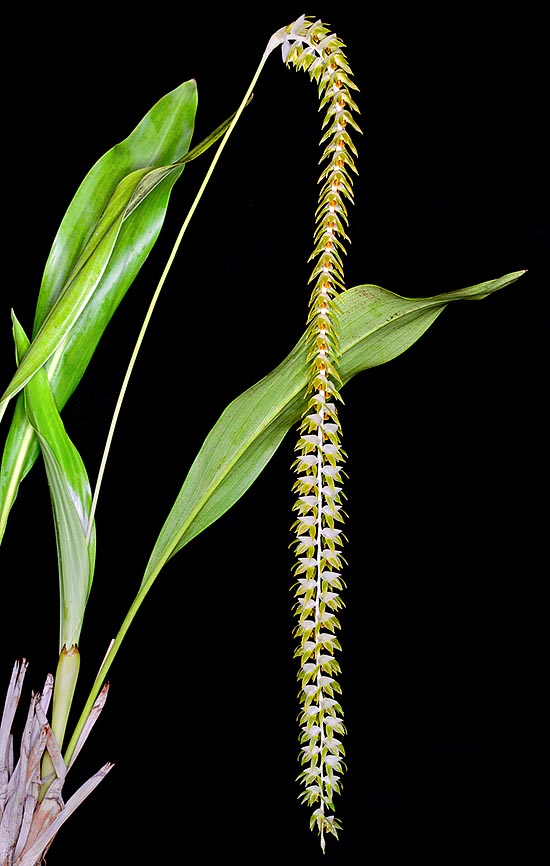Family : Orchidaceae

Text © Pietro Puccio

English translation by Mario Beltramini

Dendrochilum latifolium var. Macranthum is a Philippines epiphyte with short creeping rhizome and conical 3-8 cm pseudobulbs. They have only one leaf even 50 cm long with 20 cm long petiole © Giuseppe Mazza
The name of the genus is the combination of the Greek substantives “δένδρον” (dendron) = tree and “χεῖλος” (cheilos) = lip, with reference to its epiphytic nature and to the prominent labellum; the specific name is the combination of the Latin adjective “latus, a, um” = wide and of the substantive “folium, ii” = leaf, that of the variety is the combination of the Greek adjective “μακρός” (macrόs) = great and of the substantive “ἄνθος” (anthos) = flower, with obvious reference.
Common names: necklace orchid (English).
The Dendrochilum latifolium var. macranthum (Schltr.) H.A.Pedersen (1997) is an epiphytic species with short creeping rhizome from which originate conical pseudobulbs, 3-8 cm long and of 1-1,5 cm of diameter, with at the apex one leaf, on a 10-20 cm long petiole, elliptic-lanceolate with pointed apex, 20-50 cm long and 4,5-8 cm broad, coriaceous. Racemose inflorescences, on erect peduncle, 10-45 cm long, that develop simultaneously with the new pseudobulb and the new leaf, abruptly drooping, 15-35 cm long, bearing a multitude of tight distichous flowers, of about 1,5 cm of diameter, intensely perfumed, with greenish yellow sepals and petals and orange yellow labellum. Pointed floral bracts, 10 mm long and 7 mm broad, lanceolate sepals with pointed apex, about 11 mm long, elliptic-lanceolate petals with pointed apex, about 8 mm long and 2 mm broad, trilobed labellum, 4 mm long, with triangular lateral lobes, about 1 mm long, and obovate median lobe with obtuse apex and irregularly crenate margin, 3,5 mm long and 2 mm broad.
It reproduces by seed, in vitro, and by division at the end of the blooming.
Species of easy cultivation, among the biggest of the genus, forming in short time wide tufts, requires a slightly shaded exposition, medium-high temperatures, 22-32 °C in summer, slightly lower in winter, with night lowest ones not under the 13 °C, high humidity and, fundamental, a good ventilation. Frequent waterings from spring to autumn, more spaced in winter letting the compost to partially dry up before giving water again, utilizing rain water, demineralized or by reverse osmosis. Fertilizations every two weeks from spring to autumn utilizing a balanced hydrosoluble product, with microelements, at ¼ of dosage shown on the package. It is usually cultivated in pots or baskets with compost that can be formed by finely sliced bark fragments, charcoal and sphagnum. The repottings are to be done, when necessary, after the blooming at the appearance of the new roots.

Racemose inflorescences, on erect peduncle, developping simultaneously with the new pseudobulb and the new leaf, suddenly drooping, 15-35 cm long. They bear a crowd of tight tiny distichous flowers, of about 1,5 cm of diameter, intensely perfumed, with greenish yellow sepals and petals and orange yellow labellum © Mazza
Synonyms: Dendrochilum grandiflorum Schltr. (1910); Dendrochilum cagayanense Ames (1911); Dendrochilum macranthum Schltr. (1911); Dendrochilum serratum L.O.Williams (1937).
→ For general notions about ORCHIDACEAE please click here.
